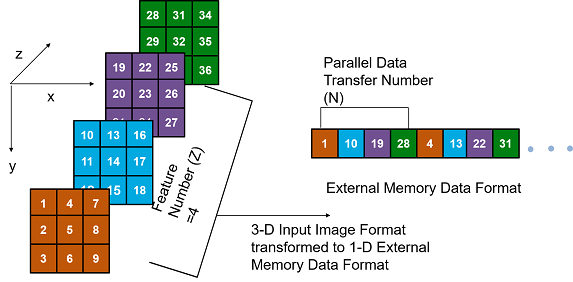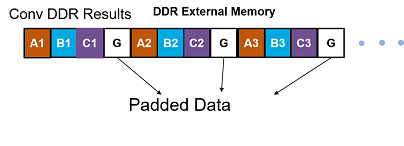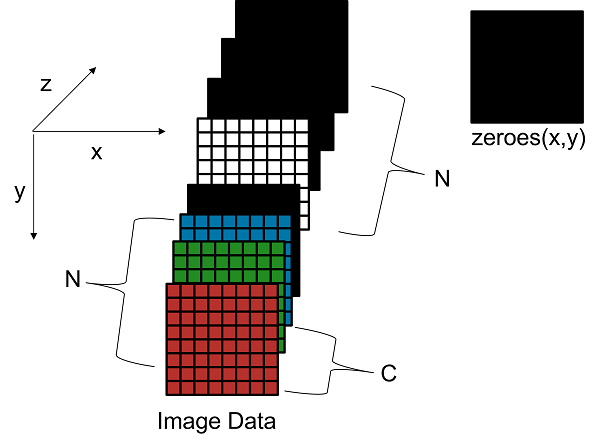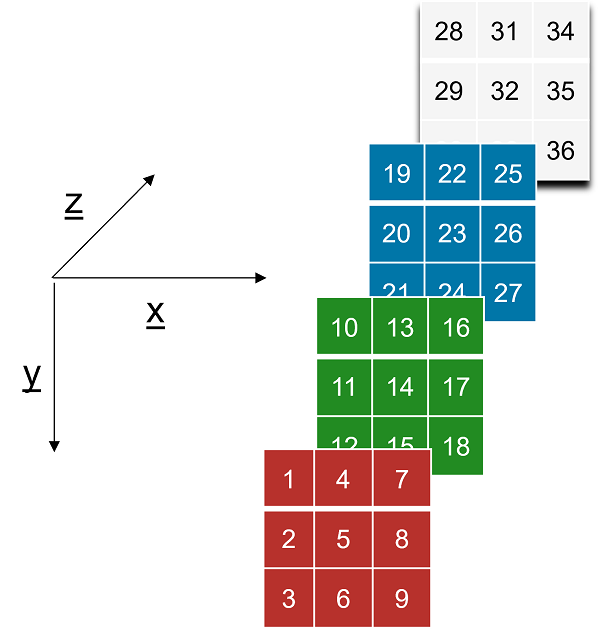External Memory Data Format
To load the input image to the deployed deep learning processor IP core and retrieve the
output results, you can read data from the external memory and write data to the external
memory by using the dlhdl.Workflow workflow. This workflow formats your
data. Or, you can manually format your input data. Process the formatted output data by using
the external memory data format.
Key Terminology
Parallel Data Transfer Numberrefers to the number of pixels that are transferred every clock cycle through the AXI master interface. Use the letterNin place of theParallel Data Transfer Number. Mathematically N is calculated aspower(2,nextpow2(sqrt(ConvThreadNumber))). For example, if the convolution thread number is nine, the calculated value of N is four. See ConvThreadNumber.Feature Numberrefers to the value of the z dimension of an x-by-y-by-z matrix. For example, most input images are of dimension x-by-y-by-three, with three referring to the red, green, and blue channels of an image. Use the letterZin place of theFeature Number.Thread Numberrefers to the number of channels of the input that are operated upon simultaneously in a convolution style layer. Use the letterCin place of theThread Number. MathematicallyCis calculated assqrt(ConvThreadNumber). For example, if the convolution thread number is nine, the calculated value ofCis three. See ConvThreadNumber.
Convolution Module External Memory Input Data Format
The single data type inputs of the deep learning processor
convolution module are typically three-dimensional (3-D).The external memory stores the data
in a one-dimensional (1-D) vector. Converting the 3-D input image into 1-D to store in the
external memory:
Sends
Nnumber of data in thezdimension of the matrix.Sends the image information along the x dimension of the input image.
Sends the image information along the y dimension of the input image.
After the first
NXYblock is completed, we then send the nextNXYblock along thezdimension of the matrix.
The image demonstrates how the data stored in a 3-by-3-by-4 matrix is translated into a 1-by-36 matrix that is then stored in the external memory.

Data Padding for Power of Two Thread Numbers
When the image Feature Number (Z) is not a multiple of the
Parallel Data Transfer Number (N), then we must pad a zeroes matrix
of size x-by-y along the z dimension of the matrix to make the image Z
value a multiple of N.
For example, if your input image is an x-by-y matrix with a Z value
of three and the value of N is four, pad the image with a zeros matrix
of size x-by-y to make the input to the external memory an x-by-y-by-4 matrix.
This image is the input image format before padding.

This image is the input image format after zero padding.

The image shows the example output external memory data format for the input matrix
after the zero padding. In the image, A, B, and C are the three features of the input
image and G is the zero- padded data to make the input image Z value
four, which is a multiple of N.

If your deep learning processor consists of only a convolution (conv) processing
module, the output external data is using the conv module external data format, which
means it possibly contains padded data if your output Z value is not a
multiple of the N value. The padded data is removed when you use the
dlhdl.Workflow workflow. If you do not use the
dlhdl.Workflow workflow and directly read the output from the external
memory, remove the padded data.
Data Padding for Non-Power of Two Thread Numbers
When the Thread Number
C is not a power of two and lower than N, then we must pad a zeroes
matrix of size x-by-y along the z dimension of the matrix. The zeroes matrix is inserted
after every C number of elements along the z dimension of the matrix to make the Z value a
multiple of N.
For example, if your input image is an x-by-y matrix with a C value
of three and N and Z values of four, pad the image
with a zeroes matrix of size x-by-y after the third channel and three zeroes matrices of
x-by-y after the fourth channel to make the input to the external memory an
x-by-y-by-eight matrix.
This image is the input image format before padding.

This image is the input image format after zero padding.

This image shows a sample three-by-three-by-four matrix passed as an input to a deep
learning processor configuration with a C value of three and
N value of four.

The image shows the example output external memory data format for the input matrix after the zero padding.
![]()
When the values of C and N are equal, padding is
required only when Z is not a multiple of C.
Convolution Module External Memory Output Data Format
The single data type outputs of the deep learning processor
convolution module are typically three-dimensional (3-D).The external memory stores the
data in a one-dimensional (1-D) vector. The external memory uses four bytes for a value.
If the Thread Number is four, then four single values are concatenated
into a 128-bit wide vector and stored in the external memory. When the
single data type is stored in the memory the addresses are
incremented in steps of four.
This example describes how the padded input data for a 3-by-3-by-5 matrix with
Thread Number four is recovered from a 1-D vector in the external DDR
memory. The original input size is a 3-by-3-by-5 matrix and the Thread
Number is four. To make the third dimension a multiple of four, three
3-by-3-by-3 matrices are padded to make the padded input to the external memory a
3-by-3-by-8 matrix. The 3-by-3-by-8 matrix is converted into a 1-by-72 vector in the
external memory. To convert the 1-D memory data back into a 3-D output matrix:
Sends
Cnumber of data in thezdimension of the matrix.Sends the image information along the x dimension of the input image.
Sends the image information along the y dimension of the input image.
After the first
CXYblock is completed, we then send the nextCXYblock along thezdimension of the matrix.
This image demonstrates how the data in a 1-by-72 vector in memory is translated into a 3-by-3-by-8 matrix as the convolution module output.

As part of the post-processing, remove the three 3-by-3 matrices with zero data and return the output 3-by-3-by-5 matrix.
int8 Data Type External Memory Format. The int8 data type outputs of the deep learning processor
convolution module are typically three-dimensional (3-D).The external memory stores the
data in a one-dimensional (1-D) vector. The external memory uses one byte for a value.
If the Thread Number is four, then one byte per thread is
concatenated into a 32-bit wide vector and stored in the external memory. When the
int8 data type is stored in the memory the addresses are
incremented in steps of one.
Calculation of Output Memory Size
The size of the output for a deep learning processor IP core depends on the
Feature Number(Z), Thread Number (C), and the
Parallel Data Thread Number (N). The formula to calculate the output
memory size is dimension1 * dimension2 * ceil(Z/C) * N. For example,
for an input matrix of size three-by-three-by-four the output memory size for a
C and N value of four is 3 *3 *ceil(4/4)
*4 = 36. In this example the output is written four values at a time because
the value of N is four.
For a three-by-three-by-four matrix with a C value of three and
N value of four, the output size is 3 *3 *ceil(4/3) *4
=72. In this example even when the output is written four values at a time
only the first three values are valid as the fourth value is a zero padded value.
Fully Connected Module External Memory Data Format
If your deep learning network consists of both the convolution (conv) and fully connected (fc) layers, the output of the deep learning (DL) processor follows the fc module external memory data format.
The image shows the example external memory output data format for a fully connected output feature size of six. In the image, A, B, C, D, E, and F are the output features of the image.
